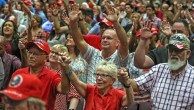by Andrew Kohut, President, Pew Research Center Special to the New York Times
The post-convention polls are in and they show John McCain getting quite a bounce from his convention. He not only wiped out the lift in the polls that Barack Obama got from his convention, but he is now polling better than he has at any point this year in most surveys.

The CBS poll, which was conducted from Sept. 5 to Sept. 7, has McCain at 46% and Obama at 44% among a national sample of registered voters. Prior to the conventions that poll tipped to Obama — 45% to 42%. The ABC/Washington Post survey taken at the same time shows a similar trend. And the Gallup surveys show an even more pronounced gain in support for the Republican candidate among registered voters, with McCain leading with 50% to Obama’s 46%. Other national polls also show movement in a Republican direction. There is little doubt that the fall election campaign begins in earnest with McCain having gained the momentum.
The question is, how good an indicator is this of where the electorate is headed on Nov. 4? A historical look at recent elections shows mixed results. In five of the seven elections since 1980, the candidate with the lead in early September went on to victory in November. In only two elections did the leading candidate go on to lose the election. But the record also suggests that when there was a change in momentum, in three cases that candidate won the election, and in two he was defeated.
In 1980, the Gallup poll found President Jimmy Carter tying the race after the Democratic convention, having trailed challenger Ronald Reagan by as much as 53% to 37% during the summer. President Carter maintained a small lead through much of the fall, only to lose it for good in late October after the only presidential debate.
In 1984, President Reagan held a sizable lead over his Democratic opponent in Gallup polls both before and after the G.O.P. convention — and easily won the election by a huge 59% to 41% margin.
Vice President George H.W. Bush trailed Michael Dukakis in the polls for much of the spring and summer of 1988. But he jumped to a nine-point lead in the Gallup poll following the Republican convention, and never trailed Dukakis again.
Bill Clinton registered a solid gain in support from the 1992 convention, even though much of the dynamic in his campaign against incumbent President Bush came from Ross Perot, the third party candidate, dropping in and out of the race. The 1996 election was never much of a contest. President Clinton held a big lead both before and after the convention, and there was little movement in voter attitudes.
In 2000, Vice President Al Gore got a boost from the Democratic convention. Before the conventions, a survey by Professional Research Consultants showed the race neck and neck, with George W. Bush at 42% and Gore at 41%. Their September survey found Gore leading at 47% and Bush at 41%. But the vice president’s momentum did not hold, ultimately ending up as one of the closest elections in recent American history.
In 2004, President Bush gained support following the Republican convention and led challenger John Kerry with 49% to 43% in Pew’s early September survey. However, the race tightened subsequently.
